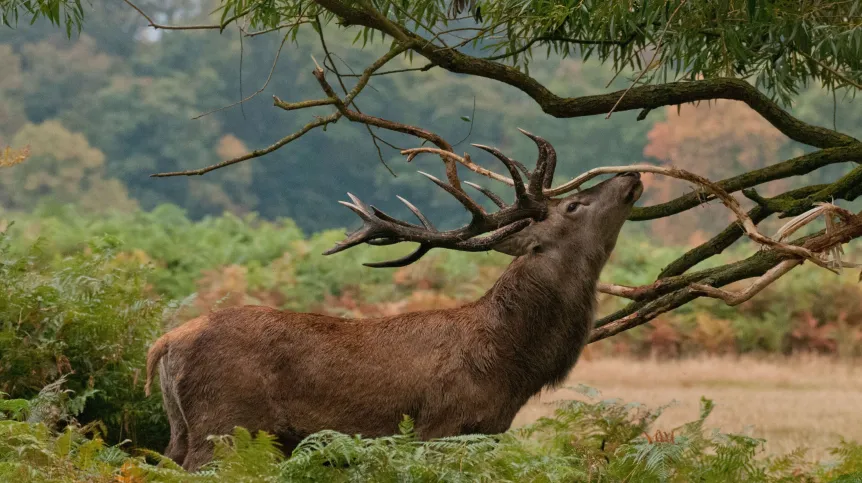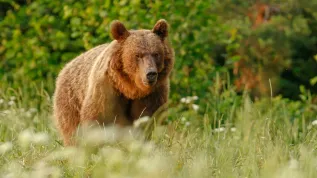
Red deer in Poland are not vectors or reservoirs of the SARS-CoV-2 virus, which means that they do not participate in spreading it to subsequent organisms. However, taking into account different reports from North America, it is necessary to monitor the wild population in Poland.
In the journal Viruses, an international group of scientists, including Polish researchers, described the results of their latest study on whether one of the most numerous deer species in Europe - the red deer - can be a reservoir (i.e. the natural environment; source of infection) or a vector (intermediary, transmitting organism) of SARS-CoV-2.
“SARS-CoV-2 can infect some animal species, be transmitted among them, and move from animals to humans,” says Dr. Jakub Borkowski from the Department of Forestry and Forest Ecology of the University of Warmia and Mazury in Olsztyn. “The most famous example of the species, the infection of which has been detected in many places in the world, is the American mink from farms.”
In mid-2021, US research showed that coronavirus was also found in Virginia deer populations.
Dr. Borkowski says: “In connection with this, we decided to check the situation of one of the most numerous European deer - the red deer. Based on samples taken from 90 animals in Warmia and Mazury, we did not find that red deer was infected with it. Nevertheless, it is necessary to conduct biomonitoring of various animal species, both wild and farm animals, as a direction parallel with testing people.”
The American publication showed that as many as 40 percent of tested Virginia deer in the US were infected with a virus that caused the COVID-19pandemic. Other studies have shown that representatives of this species, 5 days after the experimental infection with SARS-CoV-2, excreted the virus capable of infection and produced antibodies against SARS-CoV-2. In addition, it has been proven that Virginia deer is sensitive to various variants of SARS-CoV-2 and that this species can be a reservoir of this pathogen. There was even talk about the first suspected deer to man transmission.
Based on these reports, the World Organization for Animal Health (WOAH) called for monitoring deer in all regions of the world to better understand SARS-CoV-2 infection and its circulation in various deer populations.
Scientists from the University of Warmia and Mazury together with colleagues from the Medical University of Gdańsk, the University of Helsinki in Finland and the University of Toulouse in France collected and analysed samples from 90 deer shot by hunters in five hunting districts in north-eastern Poland. They took swabs from serum and nasopharynx, and then ran two types of tests detecting the presence of SARS-CoV-2: PCR and immunofluorescence test (IFA)
None of the samples gave a positive result, which means that not one examined individual was infected with coronavirus.
The report authors say: “There is no evidence of spillover of SARS-CoV-2 from the human to deer population in Poland.
“Our results align with other European countries’ reports (...) Comprehensive studies from the United Kingdom, Austria and Germany showed no sign of SARS-CoV-2 in several deer species. This result supports the hypothesis that wild deer are not currently a reservoir for SARS-CoV-2 in Europe.”
Where do these differences come from? According to researchers, there are several factors that may be responsible. For example, the high incidence of SARS-CoV-2 in the Virginia deer can be explained by the specificity of the ACE2 receptor, which is the main receptor enabling coronavirus to penetrate the host cells. However, according to the authors, this does not fully explain the lack of detected infections in other European deer species with an ACE2 receptor sequence identical to white-tailed deer. Crucial factors to consider are the deer population distribution, ecology, and behavioural differences.
“White-tailed deer are often reported to inhabit urban and peri-urban environments. In contrast, red deer found in European forests are rarely reported to visit human settlements. This can explain the different results,” the researchers say.
In addition, although routes of Virginia deer infection are unclear, deer social behaviour might be the factor facilitating the quick spread of the pathogen. Males of the species have broad territories and social contacts, increasing the risk of contact with the virus. Intermediate hosts, such as mink, enabling transmission, as well as differences in hunting practices should also be considered. For example, animal baiting is allowed in North America, which may cause indirect contact with humans, while this practice is forbidden in Poland and in many other European countries.
“The virus responsible for the COVID-19 pandemic can infect multiple wild and domestic animals,” the authors write. “Due to the possible maintenance, dissemination and evolution of the virus, there is an urgent need to identify and monitor species susceptible to SARS-CoV-2. Animal reservoirs constitute a threat by contributing to animal–animal and animal–human transmission of viruses. Such transmissions can lead to reverse zoonosis (spillback) of novel animal-adapted variants that the human immune system has not encountered before.”
This phenomenon is well documented for SARS-CoV-2 infections of farmed mink. That is why it is so important to closely observe the epidemic situation among wild animals, especially those living near human settlements.
The authors continue: “Biomonitoring is one of the most effective methods of predicting and preventing possible epidemics. Searching for novel hosts or reservoirs of zoonotic pathogens should be a priority for public health and wildlife management institutions (...) Therefore, all efforts should be made to reduce the risk of new variant emergence and to protect both humans and wildlife.”
(FAO, WHO, WOAH, 2021 [46]). We believe that preparation for a “Pathogen X” pandemic should employ a “One Health” approach with a strong emphasis on monitoring both domestic and wild animals.
However, as they emphasize, at the moment there is no evidence that the wild red deer supports the transmission of SARS-CoV-2.
PAP - Science in Poland, Katarzyna Czechowicz
kap/ ekr/ kap/
tr. RL













